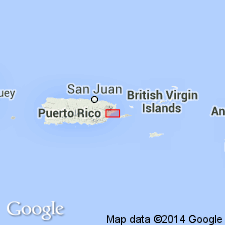
- Usage in publication:
-
- Daguao Formation*
- Modifications:
-
- Named
- Dominant lithology:
-
- Breccia
- AAPG geologic province:
-
- Caribbean region
Summary:
Daguao Formation here named in east-central PR. Consists medium-gray to medium-dark-gray andesite breccia, lava, volcanic sandstone, and crystal tuff. Thickness greater than 1,000 m. Breccia is massive, cut by fine-grained and porphyritic lava dikes. Sharply or gradationally(?) underlies Figuera Lava; base not exposed. In intrusive contact with Tertiary(?) plutonic rocks. Age is Early Cretaceous.
Source: GNU records (USGS DDS-6; Reston GNULEX).

- Usage in publication:
-
- Daguao Formation*
- Modifications:
-
- Overview
- AAPG geologic province:
-
- Caribbean region
Summary:
The Daguao Formation occurs in eastern Puerto Rico and consists of massive andesitic interbedded volcaniclastic breccia, lava, and subordinate sandstone and crystal tuff. Maximum estimated thickness is 1000 meters. The Daguao is of Early Cretaceous(?) age.
Source: GNU records (USGS DDS-6; Reston GNULEX).
For more information, please contact Nancy Stamm, Geologic Names Committee Secretary.
Asterisk (*) indicates published by U.S. Geological Survey authors.
"No current usage" (†) implies that a name has been abandoned or has fallen into disuse. Former usage and, if known, replacement name given in parentheses ( ).
Slash (/) indicates name conflicts with nomenclatural guidelines (CSN, 1933; ACSN, 1961, 1970; NACSN, 1983, 2005, 2021). May be explained within brackets ([ ]).

